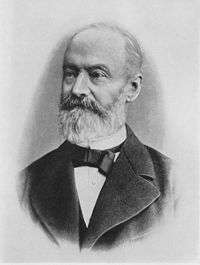Julius Pintsch

Carl Friedrich Julius Pintsch (6 January 1815 – 20 January 1884) was a German tinsmith, manufacturer and inventor who is primarily known for the invention of "Pintsch gas".
Life
Born in Berlin, Pintsch completed an apprenticeship as a tinsmith in 1833 and after his journeyman years took up a position at a local lamp factory. Having obtained his Meister certificate, he established his own small workshop near the municipal gasworks at Frankfurter Bahnhof in Berlin-Friedrichshain in 1843.
While the City of Berlin continuously enlarged its gas network in order to supply the growing population, Pintsch received numerous repair orders by the public GASAG utility company. He achieved major success in 1847 with the development of a reliable gas meter that was applied by the city administration and would eventually be used worldwide.
.jpg)
In 1851, he created a gas lamp that was suitable for use in railroad cars. These lamps were illuminated by Pintsch gas; a long-burning oil gas that would remain lit during the rough motion of train journeys. Pintsch gas was essentially purified, compressed gas distilled from naphtha that was regulated and reduced to 1/3 ounce per square inch of pressure to the burner. Pintsch gas was later replaced by an improved Blau gas for railroad car usage.
Starting in 1863, Pintsch had a large factory built on Andreasstrasse in Berlin; followed by subsidiaries in Dresden, Breslau, Frankfurt, Utrecht and Fürstenwalde. These plants designed and constructed a wide range of gas-related devices including gas meters, gas pressure regulators, and gas analyzers.
After his death in 1884 in Fürstenwalde, his sons Richard, Oskar, Julius Karl, and Albert inherited the business and became successful in the manufacture of compressed Pintsch gas for use in beacons and unmanned lighthouses. The productions also included gas mantle lamps as well as light buoys used in the Kronstadt Bay and the Suez Canal. In 1907, the business was transformed into a public limited company (AG); finally broken up in 1967, some branches were later acquired by the Schaltbau GmbH Munich.
Pintsch gas
Pintsch gas was a compressed fuel gas derived from distilled naphtha used for illumination purposes during the 19th and early 20th centuries.
It was invented in 1851 by German inventor and manufacturer Julius Pintsch (1815-1884). Its primary use in the latter half of the 19th century was for illumination of railroad cars. In several railway accidents Pintsch gas lamps added fuel to any fire which started, for example, in the Thirsk rail crash (1892), Sunshine rail disaster (1908), Quintinshill rail disaster (1915), and the Dugald rail accident (1947). Lamps using Pintsch gas burned brighter and longer than the existing oil lamps they replaced. These lamps could also withstand vibration and rough usage without extinguishing the light. These features made Pintsch gas a popular solution for illumination of buoys, beacons and unmanned lighthouses, which allowed these devices to have the capability to remain lit for several months without servicing.
Electricity and other artificial means of lighting eventually replaced Pintsch illumination. However, it was still used in lighthouses and beacons long after it was replaced elsewhere.